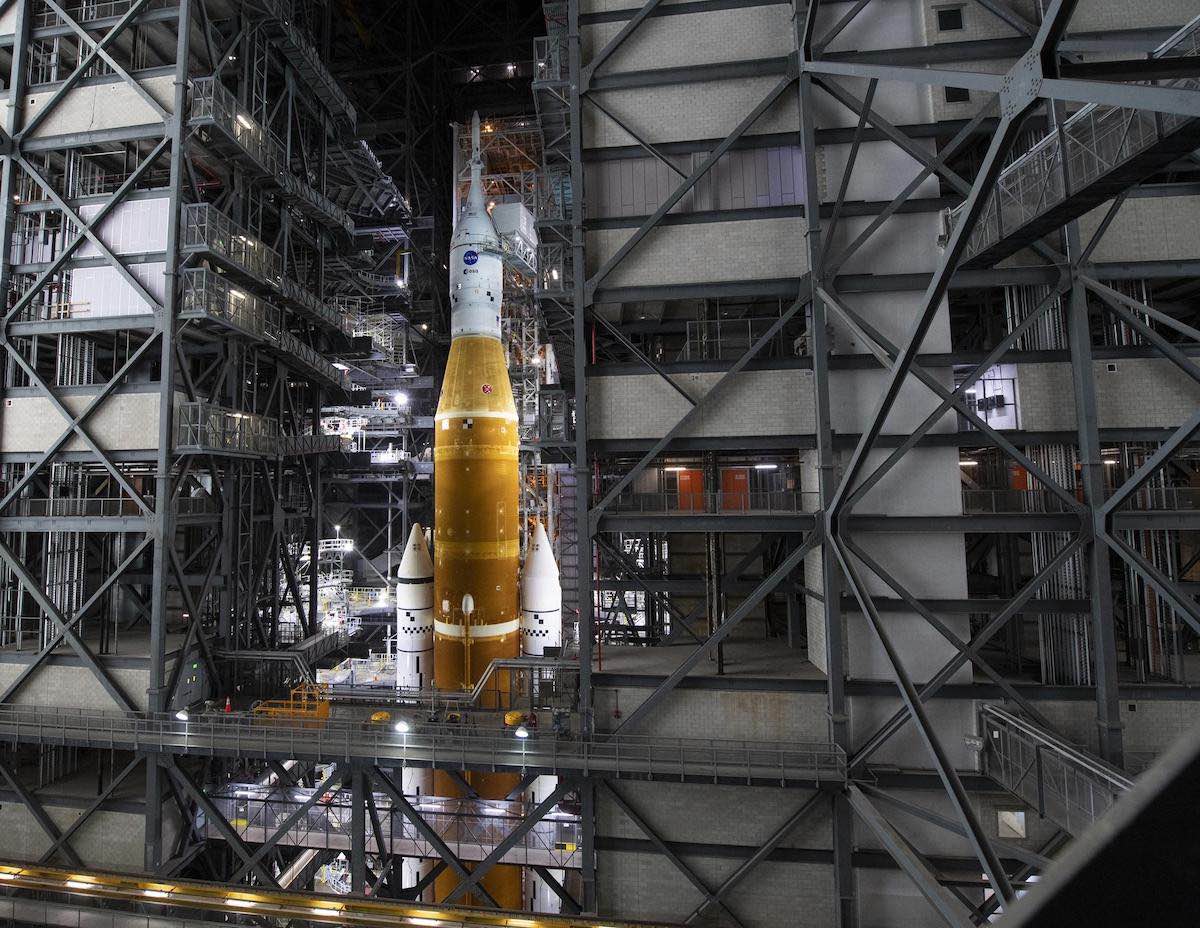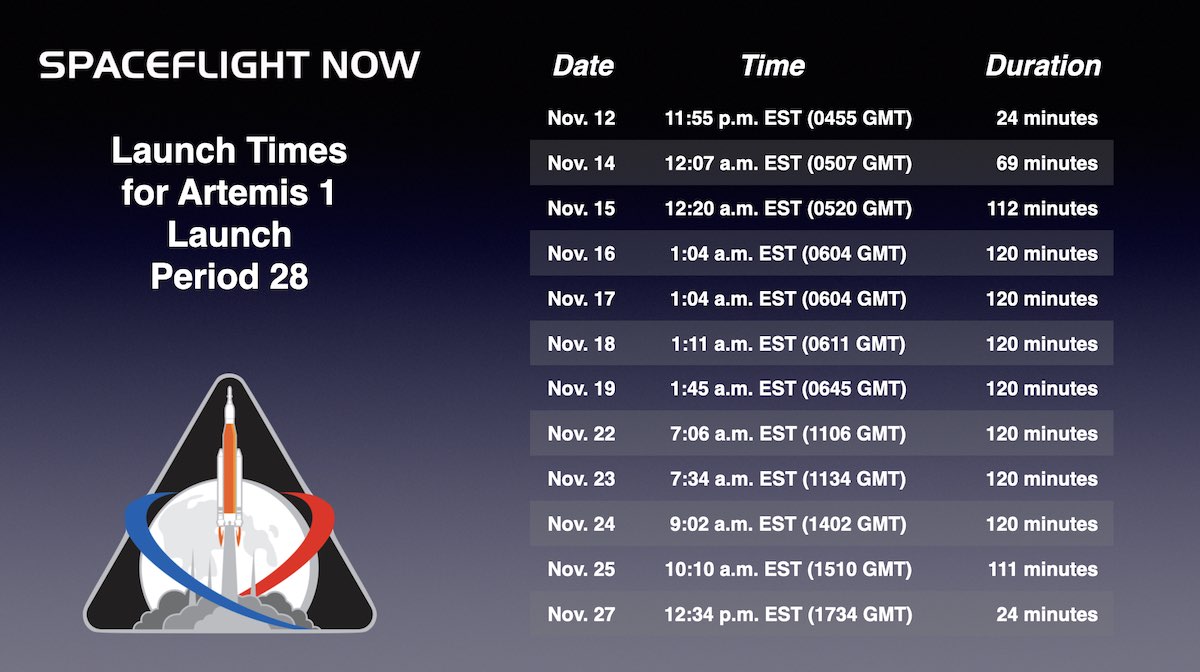
The next launch attempt for the NASA’s Artemis 1 moon rocket is scheduled just after midnight Nov. 14 after a hydrogen leak and Hurricane Ian thwarted tries to launch the unpiloted test flight to the moon in August and September, space agency officials announced this week.
Unlike the previous launch attempts for the Artemis 1 moon mission, the launch times available to NASA are mostly at night. The launch window Nov. 14 opens at 12:07 a.m. EST (0507 GMT) and extends for 69 minutes. NASA said Wednesday it has requested Nov. 14, Nov. 16, and Nov. 19 for launch opportunities on the U.S. Space Force’s Eastern Range, the unit responsible for public safety and launch scheduling on Florida’s Space Coast.
The launch windows Nov. 16 and Nov. 19 open at 1:04 a.m. EST (0604 GMT) and 1:45 a.m. EST (0645 GMT). Each day has a launch window that runs for two hours.
On its first test flight, NASA’s huge Space Launch System rocket will send an unpiloted Orion crew capsule on a four-day voyage toward the moon. The Orion spacecraft will enter a distant retrograde orbit around the moon, executing two close flybys about 60 miles (100 kilometers) above the lunar surface on the outbound journey and then again on the return trip to Earth.
Different launch dates come with different mission profiles. Some launch dates set up the Artemis 1 mission for a shorter duration of about three-and-a-half weeks, while other launch dates have mission profiles with durations extending up to six weeks.
If the Artemis 1 test flight takes off Nov. 14, the Orion spacecraft would fly a shorter-duration 25-and-a-half day mission profile, resulting in a splashdown of the crew capsule in the Pacific Ocean on Dec. 9.
The November launch period opens Nov. 12 and runs through Nov. 27. NASA has about two weeks of launch availability in each Artemis launch period, followed by around two weeks when the mission would be not be feasible. The primary driver of the launch periods is the position of the moon in its 28-day orbit around Earth, but there are other factors, including NASA’s requirement for the trajectory to culminate in a splashdown of the Orion spacecraft in the Pacific Ocean in daytime.

NASA rolled the 322-foot-tall (98-meter) SLS moon rocket back to the Vehicle Assembly Building on Sept. 27 for safekeeping from Hurricane Ian, precluding any additional launch attempts during launch periods in October. The mission’s first launch attempt Aug. 29 was scrubbed due to a sensor problem indicating an issue thermally conditioning one of the core stage’s space shuttle-era main engines.
Officials scrubbed a second countdown Sept. 3 due to a hydrogen leak. After teams swapped out seals in the leaky hydrogen connector, NASA’s launch team loaded super-cold propellant into the rocket during a tanking test Sept. 21 to prove that the leak was fixed. NASA hoped to try again to launch the Artemis 1 test flight in late September or early October, but the threat from Hurricane Ian forced officials to return the rocket to the assembly building.
Engineers plan several tasks with the rocket back in the VAB, including swapping out batteries on the flight termination system, which range safety teams would use to destroy the launch vehicle if it flies off course after liftoff and threatens populated areas. The battery changeout work will require technicians to open an access door and enter the “intertank” section of the SLS core stage, the volume between the core stage’s liquid hydrogen and liquid oxygen tanks.
The U.S. Space Force’s Eastern Range, which is responsible for public safety for all launches from Florida’s Space Coast, granted NASA a waiver last week to extend their certification of the flight termination system batteries long enough to enable Artemis 1 launch attempts through early October. The batteries were originally only certified for 25 days, long enough to allow Artemis 1 launch attempts through early September.
Changing out and re-testing the batteries is only possible with the rocket back inside the VAB.
Workers inside the VAB will also repair minor damage to foam and cork on the rocket’s thermal insulation system, and recharging or replacing batteries on elements of the launch vehicle and Orion spacecraft. Ground teams will also recharge batteries on some of the rocket’s 10 CubeSat secondary payloads. NASA said it plans to roll the rocket back to Launch Complex 39B at Kennedy Space Center as soon as Nov. 4.
The Artemis 1 test flight is a precursor to future astronaut missions to the moon aboard the SLS moon rocket and Orion spacecraft. The second Artemis mission, called Artemis 2, will launch a crew of four astronauts on a loop around the far side of the moon as soon as 2024, and NASA aims to use a commercial lander built by SpaceX for trips to and from the lunar surface later this decade.
Email the author.
Follow Stephen Clark on Twitter: @StephenClark1.
